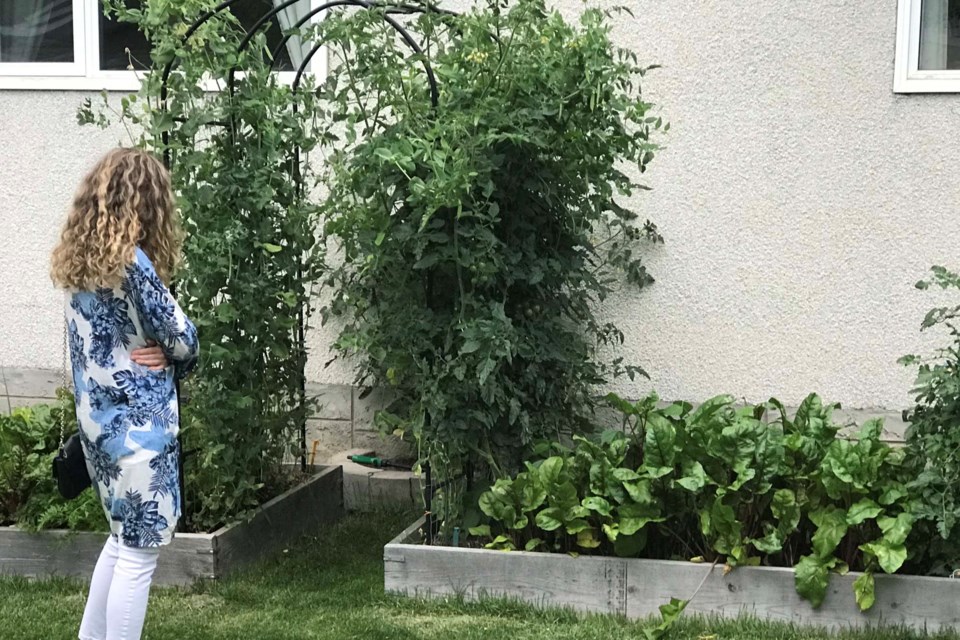Close to 40 gardeners curious to learn about growing food turned out to mark the fourth annual St. Albert Community Edible Garden Tour.
The tour’s purpose is to raise awareness about food that could be grown in a Zone 3 climate and spur conversation around the issues of food security, said lead organizer Jill Cunningham.
Every year tour participants meet at a different spot. This year it was St. Albert Community Food Forest.
Located on a hill sandwiched between Meadowview Drive and Meadowview Ball Diamonds, the wild, unkempt-looking edible forest is a work in progress.
Once it was a pasture and later a market garden. Today dedicated volunteers are changing its face, planting plum, apple and Evans cherry saplings as well as saskatoons, raspberries, jostaberry and haskap berry bushes.
One of the forest’s most impressive features is the overlooked passive water collectors shaped from soil that give the hill a terraced looking quality.
Just a short climb away is the Heritage Garden, a fenced vegetable garden roughly an acre in size. Local master gardener Irene Szambara has volunteered to grow lush beets, carrots, potatoes and cucumbers destined for the St. Albert Food Bank.
“This is also intended as a demonstration garden to show people new to the community what they can grow here,” said Cunningham.
At this point, the tour divides into two different groups led by Cunningham and treasurer Sandra Casson.
Casson believes the yearly tours are successful in part because, “People are curious and they like to see what’s in their neighbour’s back yard. They are looking for inspiration.”
I hopped a ride with Casson and our first stop is at Christal Myner’s home to see several egg-laying hens. Myner’s backyard is huge with a manicured green grass, richly coloured flowers and a traditional looking stone wall.
The hens roam the yard, peck at rocks and fertilize the earth. In one corner is a wire mesh coop that in winter is wrapped with a heavy-duty plastic wrap to keep out extreme cold and heated with a 60-watt bulb.
We learn the four hens lay on average one egg each per day. That is about two dozen organic eggs every week. Rough calculations suggest that there is no cost gain from raising your own chickens. “But these eggs are fresh and healthy,” said Christal Myner.
Our next stop is Joanne Gleason’s massive Grandin backyard to see three speckled hens. While most local backyards are flat, Gleason’s slopes upward. Coupled with more than half a dozen spruce trees, native growing poplar and saskatoon trees, it creates a wild, mountainous impression.
Nestled among the trees is a roomy, insulated chicken coop. One woman starts the conversation asking Gleason about smells and how often the coop is cleaned.
“I do it every day. I’m conscientious of my neighbours and I don’t want strong odours,” replied Gleason
She adds that her hens can get vocal. “They squawk when they produce and egg. I had to get permission from neighbours three houses down both sides and across the street.” Everyone laughed.
Across town in Braeside, Brenda Harvey has created rich compost-filled beds using shredded newsprint, autumn leaves and food scraps. The proof is in the plants – seven-foot-high sugar snaps and six-foot-tall tomato plants.
“I don’t dig. I don’t turn it over. I let it decompose just like Mother Nature,” said Harvey. “The more you feed the organisms, the undersoil becomes more fertile.”
Two gardeners dropped out at the last minute and Casson stepped in to show off her L-shaped yard in Erin Ridge showcasing a mix of zucchini, lamb’s ear, black currants, rhubarb and grapes.
“With grapes, patience is the key,” Casson said.
The tour ended at Cunningham’s home where she introduced stella d’oro, an edible star-shaped daylily in her front yard. The backyard was clustered with Arctic kiwi, buckwheat, French tarragon, wild raspberries, strawberries and a crabapple tree.
Marsha Grimes, one of the tour participants noted, “We are destroying our earth with concrete buildings. It’s nice to see our heritage continuing with younger people. I’m proud of St. Albert. It’s almost like an underground movement.”




